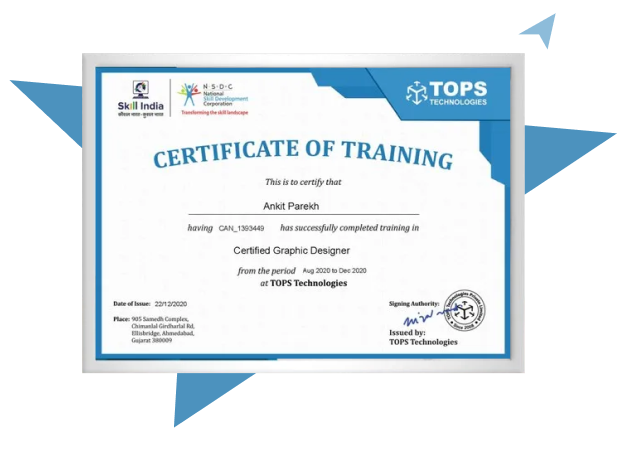Our Facts and Figures
1 Lac+
Student Placed
3000+
Companies TieUp
19+
Offices in India
50+
Industry Courses
Get 100% Job Assistance by enrolling in Certified Manual Testing Training Course
Key Highlights
Limited Students Batch
Personalised Attention
Highly Qualified Teachers
Flexible Batch Timings
Interactive Learning
Live Projects
Career Support
Job Oriented Training
Manual Testing Course Highlights
Enroll to Kickstart or Boost Your Career in Manual Software Testing
This Manual Testing Course in Gandhinagar is skewed towards preparing students for a lucrative job in the IT industry. The sprawling IT industry in Gandhinagar makes up for a competitive place for working professionals and upgrading is the key to scale up your career.
The Manual Software Training is aimed at working professionals to upgrade their skills in software testing and improve their job profile. Experts at TOPS offer comprehensive training in Manual Testing that includes hands-on experience in Defect Reporting Tools, Selenium IDE, Performance Testing Tools, and Documenting Issues/bugs.
Over 10,000 students have redefined their careers with TOPS training. Get the breakthrough that you always wanted in an IT industry with TOPS Manual Software Testing Course in Gandhinagar. Take a risk-free demo at TOPS Technologies Gandhinagar training center to decide for yourself.
For any queries regarding the Manual Testing Course, kindly email us at inquiry@tops-int.com or Call us at 7622011173. Modifying training as per your needs TOPS Technologies are experts in customizing Manual Testing courses for your colleges and offices. Our trained professionals are available to provide Manual Testing Training by organizing a batch at your convenient place; College or Office in Gandhinagar.
40%
Average Salary Hike
4.5 Lacs
Highest Salary
3000+
Hiring Partners
Join Our Free Upcoming Webinar
Cyber Security with AI
07 Dec 2025, 12:30 PM
Trainer
Faruk Pathan
(Sr. Technical Trainer)
Data Science with AI
07 Dec 2025, 04:00 PM
Trainer
Dhrumil Joshi
(Sr. Technical Trainer)
Prepare For A More Cyber Security Trends
09 Dec 2025, 04:00 PM
Trainer
Faruk Pathan
(Sr. Technical Trainer)
How to Become a Data Scientist
10 Dec 2025, 04:00 PM
Trainer
Dhrumil Joshi
(Sr. Technical Trainer)
Graphic Designing Career
11 Dec 2025, 04:00 PM
Trainer
Parth Patel
(Sr. Technical Trainer)
Learn Python in 60 Minutes
12 Dec 2025, 04:00 PM
Trainer
Sanket Chauhan
(Sr. Technical Trainer)
Motion Graphics and Animation in Design
14 Dec 2025, 11:00 AM
Trainer
Saurabh Verma
(Sr. Technical Trainer)
Career in Data Science
14 Dec 2025, 12:30 PM
Trainer
Dhrumil Joshi
(Sr. Technical Trainer)
How to Protect your Website from Hackers
14 Dec 2025, 02:00 PM
Trainer
Faruk Pathan
(Sr. Technical Trainer)
How to Create Dynamic Websites in Python with Django
14 Dec 2025, 04:00 PM
Trainer
Sanket Chauhan
(Sr. Technical Trainer)
How to Protect your Website from Hackers
09 Dec 2025, 10:00 AM
Trainer
Faruk Pathan
(Sr. Technical Trainer)
Manual Testing Course Curriculum
Download Curriculum- Introduction to Manual Testing
- Introduction of Students
- Career in Manual Testing
- Working on Project and Assignment
- Using Lab
- Fundamentals
- What is Testing?
- Testing Activities
- Test Objectives
- Objectives and purpose
- When and Why Testing?
- When to start and stop Testing?
- 7 Key Principles of Testing
- Error, Bug, Defects, and Causes of Defects
- Quality, Risk: Types of Risks.
- Test Organization :
- (Tester, Test Leader, Test planning, QA v/s QC, Testing V/s Debugging )
- Test Development Process:
- Introduction, Test Analysis, Test Plan, Strategy, HLR, Script, Scenario, Cases, Traceability Start HLR in Practically
- Fundamental Test Process:
- STLC, Psychology of Testing
- Start TestCase in Practically
- Software Development Model:
- (V-Model and RAD)
- Software Testing Levels:
- Unit Testing, Integration Testing, System Testing, Acceptance Testing, Alpha and Beta Testing, Testing definitions as per ISTQB.
- Start Scenario (Positive / negative) Practically(Minimum 21 scenario)
- Test Design Techniques
- Dynamic Testing :
- Functional and Non Functional Testing
- Black Box Testing Techniques
- White Box Testing Techniques
- Experience-Based Testing Techniques
- Maintenance Testing
- Other Testing :
- Smoke and Sanity
- End to End, Retesting and Regression
- Positive and Negative
- Static Testing (Formal, Informal, Types of Review, Estimation Techniques)
- Start Defect Report
- Agile Testing
Our TOPS Training Centers in India
Course Key Features
Skills Covered
Job Roles
Get Training Certificate by Government
Recognized NSDC/Skill India

- National Skill Development Corporation
- Supported by the vision of PM Shri Narendra Modi
- Certification by NSDC SkillIndia
- Valid for all Jobs and College Training
- International Recognition

FAQ
Beta testing is done by real users in a real environment before the final release. It helps gather feedback and identify last-minute issues.
Alpha testing is performed by internal staff to detect bugs before releasing the software to external users. It’s an early form of user acceptance testing.
The primary goal is to ensure the software behaves correctly and meets user expectations through human observation and judgment, without using automation.
Usability refers to how easy and intuitive the application is to use. Manual testers often evaluate this by simulating typical user behaviors.
By thoroughly understanding requirements, writing effective test cases, continuously reviewing results, and logging clear, detailed defects, testers can maintain high-quality standards.
Manual testers should have strong analytical thinking, attention to detail, good communication, documentation skills, and a solid understanding of software life cycles.
This approach uses predefined lists of conditions or rules to validate software. It’s especially useful when quick, repeatable assessments are needed.
A walkthrough is an informal review of documents or processes where the author explains content to peers. It helps identify gaps or mistakes early.
A test environment includes hardware, software, network configurations, and tools required to test the application. It should mimic production conditions for accuracy.
In agile, manual testing enables quick feedback through continuous, short testing cycles. Testers work closely with developers to ensure quality in fast-paced iterations.
Interview Questions
I use tools like Excel, Google Sheets, or test management platforms to organize test cases, scenarios, and results. I keep documentation up-to-date and version-controlled, ensuring that it reflects the latest changes and findings.
I check for field validations, maximum/minimum lengths, special characters, empty inputs, format restrictions (like email or date), and proper error messages. Each field is tested with valid and invalid inputs to confirm robustness.
Alpha testing is conducted by internal teams before releasing the software to actual users. It is done in a controlled environment to identify bugs that developers may have missed. It ensures readiness for beta testing or deployment.
I input different combinations of valid and invalid data to check if validation messages and logic work correctly. For example, entering incorrect date formats or leaving mandatory fields blank helps ensure that proper rules are enforced.
I provide regular updates through daily stand-ups, reports, or dashboards. These include executed test cases, defect status, coverage percentage, and risks. Clear communication helps stakeholders understand testing outcomes and timelines.
Though typically used in automation, the concept of mutation testing can be applied manually by intentionally introducing changes (mutants) into the application to test the effectiveness of existing test cases. It measures test coverage strength.
A test summary report provides a concise overview of testing efforts, including total test cases, pass/fail status, defect metrics, coverage, and lessons learned. It helps stakeholders make informed release decisions.
I verify alignment, responsiveness, fonts, color consistency, navigation, and element visibility across browsers and devices. I ensure UI adheres to design specifications and provides a seamless user experience.
A good manual tester has attention to detail, analytical thinking, communication skills, curiosity, and a thorough understanding of the application. They can think from the user’s perspective and anticipate potential failure points.
To ensure reproducibility, I provide precise steps, environment details, data inputs, and screenshots or logs. I double-check the bug on multiple environments or devices if needed and document everything clearly in the bug report.









